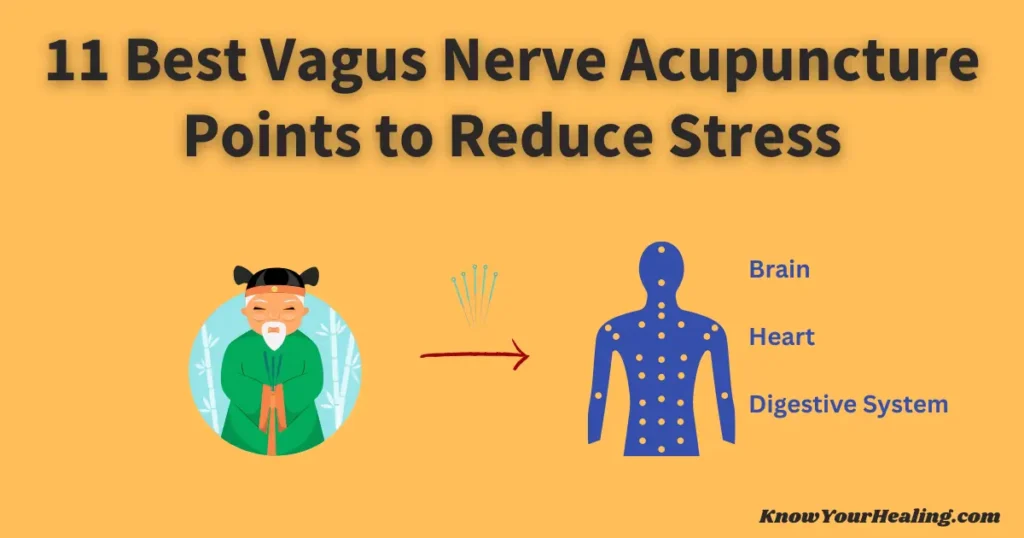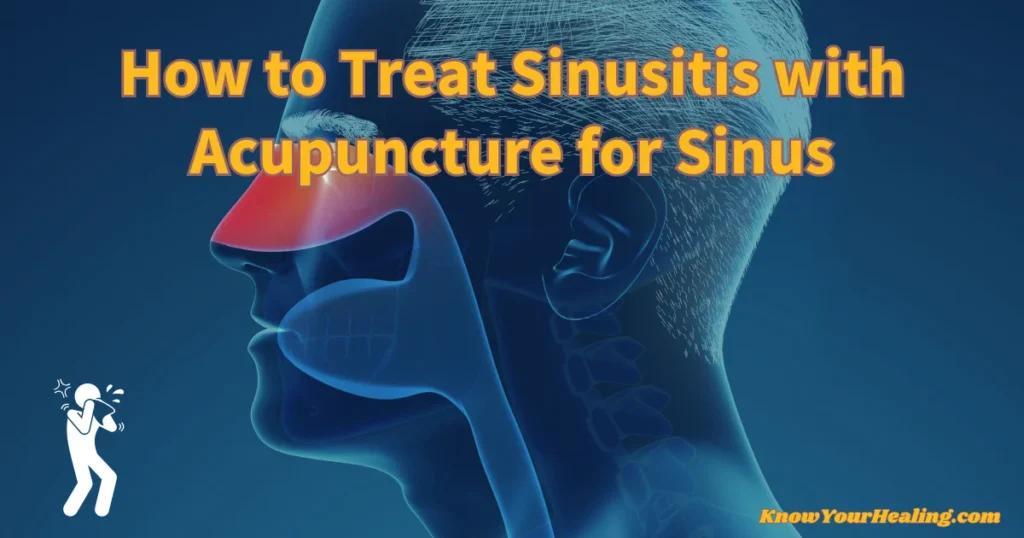Vagus nerve acupuncture points offer an effective way to manage stress. Stress can negatively impact daily life, but focusing on these points provides a solution by helping regulate the body’s relaxation response.
Exploring these acupuncture points can lead to improved well-being and stress reduction.
Acupuncture has been used for centuries to enhance health, and targeting the vagus nerve is gaining attention for its potential benefits.
By understanding how these points work, individuals can experience a more balanced and calm state of mind. This article will outline key acupuncture points linked to vagus nerve stimulation to help readers harness these advantages.
What is the Vagus Nerve?
The vagus nerve is a major nerve that starts in the brainstem and travels through the neck into the chest and abdomen.
It connects to many vital organs, such as the heart, lungs, and digestive system, and helps control heart rate, breathing, and digestion. The vagus nerve also plays a key role in helping your body relax and maintain balance.
11 Vagus Nerve Acupuncture Points to Reduce Stress
1) Heart 7 (HT 7)
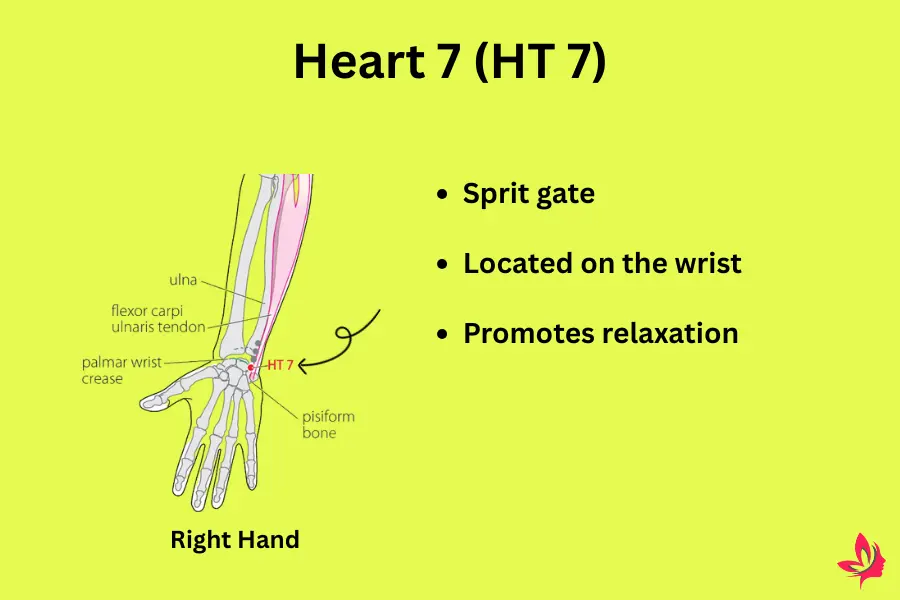
Heart 7 (HT 7) is a prominent acupuncture point on the wrist. It is crucial in promoting relaxation and reducing stress.
By stimulating HT 7, individuals may enhance vagus nerve activity, essential for calming the nervous system.
The vagus nerve is the longest cranial nerve and part of the parasympathetic nervous system. Vagus nerve stimulation through Heart 7 helps regulate heart rate variability and can lower blood pressure, making it beneficial for managing stressful situations.
Traditional Chinese medicine often highlights the importance of specific acupuncture points like HT 7 for their therapeutic benefits.
Acupuncture stimulation at this point can provide relief from anxiety and support overall mental well-being. The practice of activating HT 7 also has potential applications for those dealing with chronic stress.
In addition to mental health benefits, activating HT 7 may positively affect various bodily functions.
For example, it can help improve digestive issues by promoting a better vagal tone. This, in turn, supports the digestive tract and other vital organs by facilitating more efficient communication between the brain and body.
2) Stomach 36 (ST 36)
Stomach 36, commonly referred to as ST 36, is a key acupuncture point on the leg. In traditional Chinese medicine, it is vital for alleviating stress and promoting digestion.
This point is known explicitly for stimulating the vagus nerve, an essential component in managing various bodily functions related to stress and digestion.
The vagus nerve is the longest cranial nerve in the body and is crucial for regulating the parasympathetic nervous system. Stimulating ST 36 has been found to enhance vagus nerve activity, promote relaxation, and reduce chronic stress.
Those who experience digestive issues and stress-related health problems often benefit from treatments targeting this particular point.
Acupuncture at the ST 36 point not only aids in digestion but also plays a vital role in improving overall vagal tone.
This stimulation can help manage heart rate variability and blood pressure, key indicators of stress and cardiovascular health, by targeting the autonomic nervous system.
Clinical practice often uses acupuncture at ST 36 to address various symptoms, including digestive tract disorders and inflammatory responses.
Its activation can improve blood flow and reduce stress in the autonomic nervous system. Currently, acupuncture stimulation has shown significant effects in numerous clinical settings.
3) Pericardium 6 (PC 6)
Pericardium 6 (PC 6) is a key point in traditional Chinese medicine, located on the inner side of the wrist. Known as Neiguan, it is primarily used for emotional balance. This point is approximately three finger widths from the wrist crease, nestled between the tendons.
PC 6 is important in stimulating the parasympathetic nervous system, which can help calm the body during stressful situations. Activation of this point is believed to influence heart rate variability and enhance the body’s natural relaxation response.
Research indicates that stimulating Pericardium 6 can aid various bodily functions.
This activation reduces symptoms of nausea, anxiety, and stress. The specific acupuncture point promotes emotional wellness by easing tension and enhancing emotional stability.
Through acupuncture stimulation of PC 6, practitioners target the autonomic nervous system. This potentially influences the vagus nerve, benefiting those facing emotional stress or nervous tension.
As the longest cranial nerve, the vagus nerve regulates many vital organs and affects overall health and emotional balance.
4) Union Valley (He Gu)
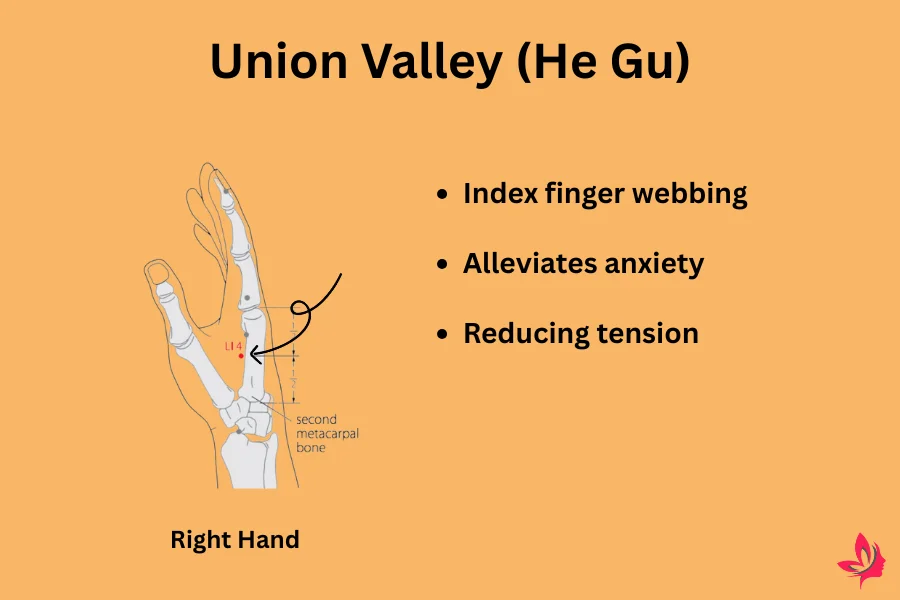
Union Valley, or He Gu, is found in the thumb and index finger webbing. This acupressure point is widely recognized in traditional Chinese medicine. It plays an important role in relieving anxiety and stress and offers a natural way to promote relaxation.
Stimulating Union Valley can enhance vagus nerve activity, crucial for calming the body’s stress response. Promoting the parasympathetic nervous system helps He Gu counteract the fight response, naturally reducing tension and restlessness.
Union Valley’s acupuncture stimulation may positively affect the autonomic nervous system.
At this point, the gentle massage or needle insertion supports homeostasis by affecting various organs, such as the heart and digestive system, making it a powerful tool for stress reduction.
Furthermore, activating He Gu can improve heart rate variability and blood flow, which is essential for maintaining balanced bodily functions.
This acupressure point provides a safer alternative to medication, reinforcing the body’s inherent ability to manage stress through non-invasive methods.
In clinical practice, the Union Valley Point is often utilized for its potential to support mental well-being.
Incorporating this technique into daily routines may significantly reduce physical and emotional stress levels, improving health outcomes over time.
Practitioners often recommend using He Gu in combination with other acupressure points. Its strategic location makes it accessible for both self-care and professional treatment, making it a versatile acupressure point for enhancing vagal tone and reducing anxiety.
5) Auricular Point
The auricular point on the ear is a specific spot used in traditional Chinese medicine to reduce stress. This point plays an important role in stimulating the vagus nerve.
The longest cranial nerve, the vagus nerve, connects to various organs and impacts bodily functions such as heart rate and breathing.
Auricular acupuncture involves stimulating these ear points with tiny needles. This practice affects the parasympathetic nervous system, promoting relaxation and reducing stress.
Studies have shown that targeting the auricular branch of the vagus nerve can enhance heart rate variability, positively impacting the body’s stress response.
In clinical practice, auricular points on the ear are used to improve vagal tone and regulate the autonomic nervous system.
This method provides an effective way to deal with chronic stress and may help manage associated health issues.
Research continues to explore the connection between auricular acupuncture and improved vagal regulation.
A safe and non-invasive technique, auricular acupuncture can be a beneficial addition to regular treatment options.
This method is simple but significantly affects managing stress and enhancing overall well-being.
Regular vagus nerve stimulation through auricular points can lead to a calmer, more balanced state of mind.
6) Bladder 10 (BL 10) – Calms the Mind, Supports Relaxation
Bladder 10 (BL 10) is an acupuncture point at the skull’s base. This point is known for calming the mind and supporting relaxation. It plays a vital role in traditional Chinese medicine due to its effectiveness in easing stress and tension.
When stimulated, BL 10 can activate the parasympathetic nervous system, which helps reduce the body’s stress response. By promoting a state of relaxation, this point can influence heart rate variability, offering a sense of calm and balance.
In addition to calming effects, acupuncture at BL 10 can be a powerful tool for stimulating the vagus nerve.
The vagus nerve, the longest cranial nerve, is crucial for various bodily functions and significantly affects stress management and overall well-being.
BL 10 can be incorporated into acupuncture sessions or used alongside other specific acupuncture points to enhance its benefits.
Its ability to regulate the autonomic nervous system makes it a part of an effective method for addressing emotional stress and improving vagal tone.
By targeting BL 10, practitioners can help individuals deal with the effects of chronic stress and encourage the body’s natural relaxation processes.
As a component of alternative medicine, this point supports individuals struggling with stressful situations, promoting a more balanced mental state.
7) Spleen 6 (SP 6)
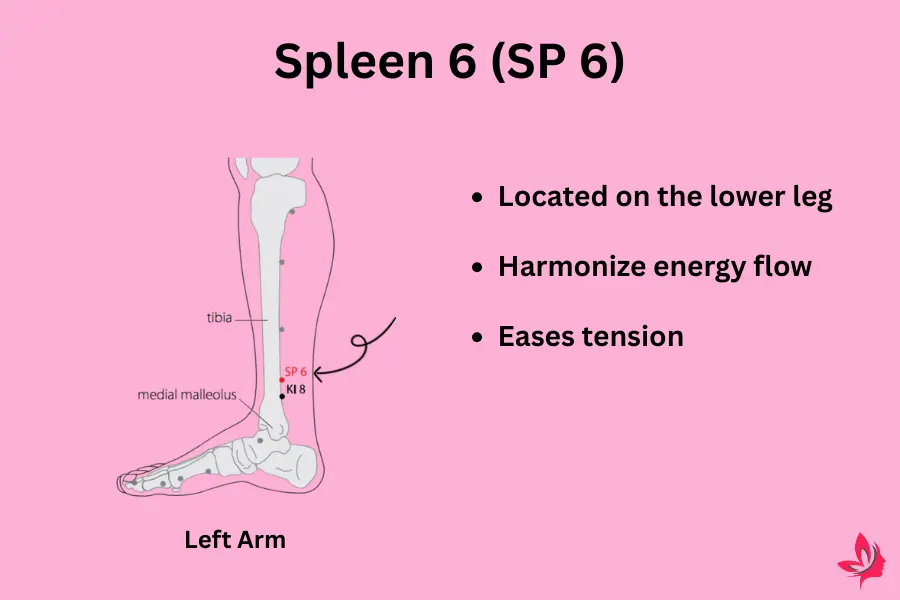
Spleen 6, also known as SP 6, plays a vital role in traditional Chinese medicine.
Located on the lower leg, this acupressure point is valued for its ability to harmonize energy flow and ease tension. It is often used to address digestive issues and emotional stress.
Stimulation of the vagus nerve is linked to the use of Spleen 6. The point can help activate the parasympathetic nervous system, promoting relaxation and reducing stress.
When stimulated, it can significantly affect the regulation of stress response and heart rate variability.
Practitioners often use SP 6 to benefit various bodily functions. It is thought to support the autonomic nervous system by helping to balance bodily energy.
This point can improve blood flow and promote well-being by influencing vagus nerve activity.
Applying pressure to specific acupuncture points like Spleen 6 is a powerful tool in acupuncture sessions.
This ancient practice is believed to impact the longest cranial nerve, aiding in managing stress and tension.
Regular stimulation can serve as an effective method for reducing the effects of chronic stress.
Those interested in incorporating SP 6 into their routines might consider deep breathing exercises alongside acupressure.
This combination can further enhance vagal tone and encourage a calm, balanced state.
8) Liver 3 (LV 3) – On the foot helps manage stress.
Liver 3 (LV 3) is a powerful acupuncture point between the first and second toes on the top of the foot. It is often used to aid relaxation and reduce stress.
This point is crucial in regulating emotions, particularly anger and frustration, which are common in stressful situations.
When stimulated, liver 3 can have a calming effect on the autonomic nervous system. This, in turn, may help decrease heart rate variability and improve overall vagal tone.
This is important as the vagus nerve is intertwined with many bodily functions, including regulating stress responses.
In Traditional Chinese Medicine, Liver 3 is known as “Great Surge,” indicating its ability to create strong internal shifts. Acupuncture at this point can enhance vagus nerve activity, promoting better emotional balance and helping manage stress levels throughout one’s daily routines.
Liver 3 may also contribute to managing chronic stress by supporting the parasympathetic nervous system, which helps the body relax after a flight-or-fight response.
Regular stimulation of Liver 3, such as through gentle massage, can be valuable to a person’s stress management toolkit.
In clinical practice, this specific acupuncture point can significantly impact a patient’s health by promoting relaxation and reducing anxiety. Liver 3 helps maintain balance in the body’s systems, offering a safer alternative to other, more invasive treatments for stress-related health issues.
9) Kidney 1 (KD 1) – Calms nerves located on the foot
Kidney 1 (KD 1) is an important acupuncture point in calming the nerves. Located on the sole, this point is often used in traditional Chinese medicine for its calming effects.
It helps manage stress and anxiety by influencing the parasympathetic nervous system.
Practitioners believe that stimulating this point can significantly reduce stress. Promoting relaxation enhances vagal tone, crucial for calming the body’s stress response.
This can be particularly beneficial for individuals dealing with emotional stress or chronic stress management.
The connection between Kidney 1 and the vagus nerve is notable. Stimulation of specific acupuncture points like Kidney 1 may influence the longest cranial nerve, which affects various bodily functions and helps regulate the body’s response to stress.
This acupuncture point can support overall well-being by affecting blood flow and improving heart rate variability.
Kidney 1 is believed to influence the autonomic nervous system, helping to improve conditions such as digestive issues and inflammatory responses.
For many, the use of acupressure at this point is an effective method to integrate into daily routines, potentially helping with conditions like irritable bowel syndrome or neurodegenerative diseases by targeting stress.
To incorporate Kidney 1 into an acupuncture session or treatment regimen, a gentle massage or thin needles can be employed.
This technique may be particularly effective for those seeking a safer alternative to more invasive treatments, as it supports the body’s natural healing processes.
10) Governing Vessel 24.5 – Between eyebrows, calms emotions.
Governing Vessel 24.5, located between the eyebrows, is also known as the Hall of Impression or Yintang in Traditional Chinese Medicine. It is considered a practical acupressure point for calming emotions and reducing stress.
Applying gentle pressure to this point can help bring a sense of tranquility, making it a popular choice in acupuncture.
Stimulation of Governing Vessel 24.5 can significantly impact the parasympathetic nervous system, crucial in managing stress responses.
This acupressure point promotes better heart rate variability and helps achieve a relaxed state by calming the autonomic nervous system.
Practitioners often incorporate this point in acupuncture sessions to aid in the reduction of anxiety and emotional stress.
The point facilitates lowering blood pressure through gentle massage or tiny needles and may assist in managing symptoms of chronic stress.
It can be a powerful tool for improving vagus nerve activity, which is linked to better overall health and emotional well-being.
Incorporating this acupressure point into daily routines, particularly during stress or anxiety, could be beneficial. The practice aligns with ancient acupressure techniques that restore balance within the body’s energy channels.
Combined with other methods, such as deep breathing exercises, this point can contribute to overall emotional regulation and stress management.
Research into the effects of activating Governing Vessel 24.5 continues to grow. Interest in its potential role in addressing stress-related health issues such as irritable bowel syndrome and cardiovascular disease is increasing within both traditional and modern fields of medical literature.
This acupressure point remains a key focus for those seeking alternative methods to promote calmness and emotional stability.
11) Conception Vessel 17
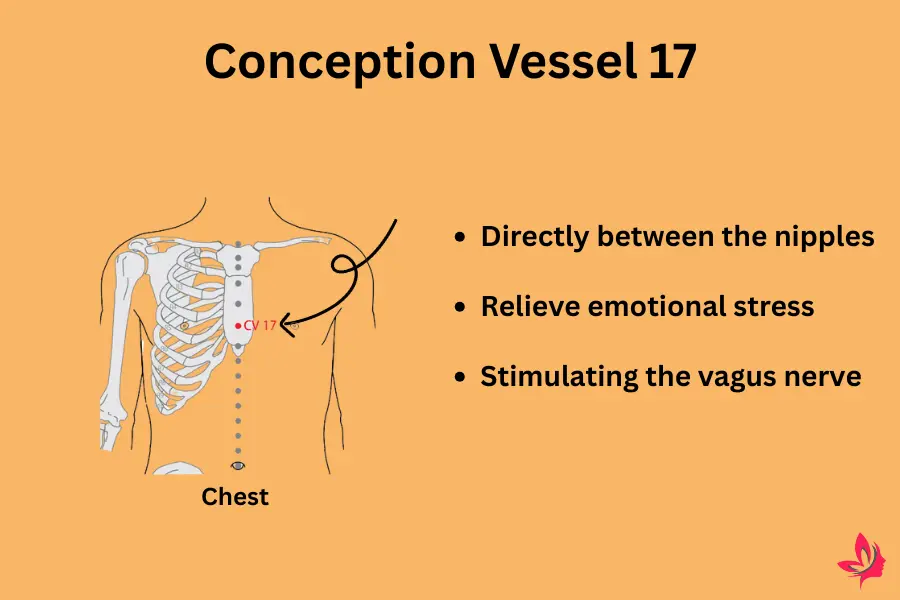
Conception Vessel 17, or CV 17, is a significant acupuncture point located on the sternum, directly between the nipples. This point is used in acupuncture to help relieve emotional stress and is a key area for vagus nerve stimulation.
Engaging with CV 17 can play an important role in activating the parasympathetic nervous system, which helps counteract the body’s stress response. Stimulating CV 17 may significantly increase heart rate variability, a measure of heart health impacted by stress and emotions.
Applying techniques like acupuncture or acupressure to CV 17 can help improve vagal tone, contributing to reduced anxiety and stress levels.
In traditional Chinese medicine, this point promotes emotional balance and supports overall well-being by regulating vagus nerve activity.
Many practitioners recommend using this point in daily routines such as deep breathing exercises or gentle massage. These practices can enhance vagal regulation and relieve chronic or emotional stress.
Research suggests stimulating specific points like CV 17 can significantly affect the autonomic nervous system. By influencing various bodily functions and helping manage stress, CV 17 offers a safer alternative to other medical treatments.
CV 17 is an effective method for stress relief for those exploring acupuncture or similar practices. It is often integrated into treatment options designed to promote emotional relief and improve overall health, demonstrating how ancient practice can benefit modern life.
Frequently Asked Questions
Understanding how the vagus nerve works and how acupuncture can stimulate it may help reduce stress and enhance well-being. This section provides answers to common questions on this topic.
What acupuncture points reset the vagus nerve?
Key acupuncture points that may help reset the vagus nerve include Heart 7 (HT 7) on the wrist and auricular points in the ear. These points are known for promoting relaxation and reducing stress.
How do you know your vagus nerve is damaged?
Digestive issues, changes in heart rate, and difficulty swallowing can be signs of vagus nerve damage. Pay attention to persistent symptoms and consult a healthcare professional for an accurate diagnosis.
Where do you massage to stimulate the vagus nerve?
Massaging specific areas, such as the neck or the back of the ears, can help stimulate the vagus nerve. Techniques such as vagus nerve massage might also support mood and digestion.
What are the symptoms of a compressed vagus nerve in the neck?
Symptoms of a compressed vagus nerve may include neck pain, dizziness, changes in voice, or difficulty swallowing. It’s essential to see a healthcare provider for a definitive assessment.
How do you unblock a vagus nerve?
Unblocking the vagus nerve can involve techniques like deep breathing, cold exposure, and acupuncture. These methods may enhance nerve function and stress relief.
Where do acupuncture needles go for anxiety?
For anxiety, acupuncture needles are often placed at points like Pericardium 6 (PC 6), near the wrist, and Union Valley on the hand. These points help in achieving emotional balance.
How do you stretch the neck to reset the vagus nerve?
Neck stretches, which involve gently extending and rotating the neck, can positively impact the vagus nerve. It’s important to perform these stretches slowly to avoid injury.
How do you realign the vagus nerve?
Realignment of the vagus nerve can involve consistent practice of stress-reduction techniques, such as meditation, yoga, or acupuncture, focusing on points like Stomach 36 (ST 36).
What resets the vagus nerve?
Exercises like controlled breathing, yoga, and acupuncture can reset the vagus nerve. Choosing activities that promote calmness and relaxation can also support nerve health.
How do you get out of the vagus nerve shutdown?
To recover from the vagus nerve shutdown, engage in activities stimulating the nerve.
Light exercise, meditation, and focused breathing techniques can help. These practices can promote a sense of calm and improve nerve function.

